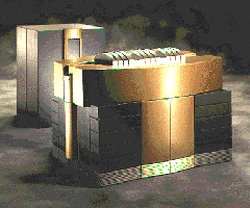The Five Qubit Fix-It

Finding and fixing mistakes in quantum computers will be a daunting task. That’s because the data in quantum machines can’t be easily copied and checked for errors. A paper in the 18 June PRL shows for the first time how to correct all errors in the smallest unit of quantum data. Using a series of radio-frequency pulses from a nuclear magnetic resonance (NMR) machine, a group of researchers introduced an error in the spin state of a nucleus and then fixed it. Experts say the results are an important step toward building quantum devices that could be used for quantum modeling and cryptography.
Normal computers have built-in error correcting systems to help them catch mistakes. Every time a computer records a bit of data (a one or zero), it makes copies that it can later compare to the original. If the original bit doesn’t match the copies, the computer concludes there’s an error and then corrects it. Quantum computers require a different kind of error correction because a quantum bit, or “qubit,” of data exists as a simultaneous combination of one and zero. When a quantum computer tries to copy a qubit, it forces the qubit to become either one or zero and destroys the information.
For years, researchers have explored alternatives for correcting errors in quantum computers. Now, a team at the Los Alamos National Laboratory in New Mexico reports that they successfully tested the most efficient such alternative, which finds and corrects mistakes using five qubits. In the Los Alamos experiment, the five qubits are the spin states of five nuclei in a linear molecule dissolved in water. Using a series of electromagnetic pulses from an NMR machine, the researchers set four of the nuclei in a “default” spin state while giving the leftmost nucleus a specific spin. They then use a series of pulses and delays to quantum mechanically “entangle” that nucleus’s spin information with its four neighbors. Next, the team introduces a random error into the spin of one of the nuclei. They then apply a second series of pulses that read the spin information back into the left-hand nucleus and determine the error from the state of its four neighbors. After determining the error, they use another series of pulses to correct the mistake.
At least, they correct it most of the time. Sometimes, unintentional errors slipped into the atoms’ spins from the complex series of electromagnetic pulses and the natural thermal relaxation of the molecules. “We could correct an intentionally applied error, but not all those other errors,” says Manny Knill, a member of the Los Alamos Team. Knill says that by the standards set forth in their own paper, the team’s work was good, but not good enough to be used in a real quantum computer.
The results still impressed David DiVincenzo of IBM’s Quantum Information Division in Yorktown, New York. The demonstration of five qubit error correction is at the frontier of current technology, he says. “This is about as good as it gets.
–Geoff Brumfiel


